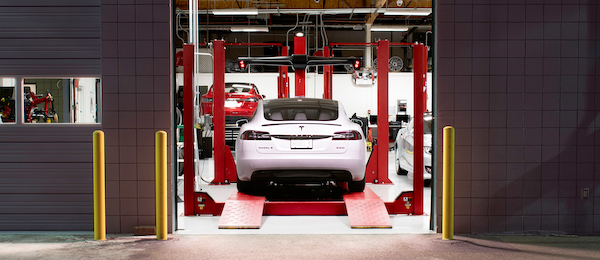Electric cars are nothing new to Brake & Front End readers. By the time the magazine was first published in 1931, the Anderson Electric Car Company had been producing them in Detroit, Michigan, for drivers like Thomas Edison, John D. Rockefeller, Jr. and famous carver Lizzie Borden.
Almost 90 years have passed, and electric cars are back. And just as in 1931, even electric cars need brakes. This month we look at what it takes to service the 2013-current Tesla Model S.
The Tesla Model S is not a spaceship. Once you pull a wheel and look at the brakes, you will quickly realize that it shares many of the same components conventional vehicles use for the brakes and suspension.
For a shop that works on brakes and suspensions, the Tesla – now and in the future – will offer many opportunities. While many Tesla drivers claim they can get more than 100,000 miles out of a set of brake pads, many will need to have the brakes serviced sooner due to noise and pulsation. The noise problem is typically due to corrosion between the steel backing plates of the brake pads and aluminum of the brake caliper. Also, even Tesla recommends the brakes should be inspected, cleaned and serviced on a regular schedule.
Tesla Service Information
Before you work on any new vehicle, it is critical to have access to service information. Tesla’s service information website can be found for a fee at service.teslamotors.com. The website has all the procedures to service the brakes and other systems on the vehicle – to be honest, the information is a little light on diagnostics.
The least expensive option is $30 for one hour of access but a full 24-hours of access will set you back $90. The site is easy to navigate and does contain critical information like torque specs and the procedures to disable power to brake components.
The most challenging part of servicing a Tesla is the lack of professional aftermarket scan tools. The Model S does have an OBDII port above the dead pedal behind a cover. But this only provides access to the power, ground and BEAN bus.
If you did have a scan tool with Tesla software, you could use it to retract the parking brake calipers, bleed the brake system and perform diagnostics. Unfortunately, the only option is Tesla’s Toolbox, but the company is very picky about who gets access. Typically, access is granted to body shops that have to go through a lengthy approval process. There are tools available online that can access vehicle modules, but these are, at best, suited to engineers or enthusiasts.
However, with the computer-driven touchscreen inside the vehicle, you can perform several tasks to service the brakes and suspension.

Two Electrical Systems
If you are servicing the brakes or suspension system on a Tesla Model S, you do not need fancy orange gloves or insulated tools. The brake system on the vehicle uses the 12-volt electrical system and not the 400-volt electrical system. Still, it is always a good practice to disconnect the 12-volt power system if you have to remove a caliper or replace a brake hose.
It is also a good idea for any vehicles with a smart key to remove the key from the bay and place it in the front office or a box that blocks the radio transmission. For some vehicles, the presence of the key might cause the ABS module to run the pump motor to energize the hydraulic accumulators.
In order to disconnect the 12-volt power system on the Model S you must access the “frunk” or front trunk. And before you disconnect the 12-volt battery you need to do two things.
First, roll the driver’s side window down. Why? The upper channel for the window is in the roof rail. When the door is opened, the electric window motor lowers the glass slightly to clear the lip of the seal. If the power is disconnected first, it can’t lower the window when the door is opened or closed. This could result in shattering the glass. This goes for the other doors on the vehicle as well. In addition, this practice prevents you getting locked out of the car.
Second, use the touch screen to disconnect the power and disengage the parking brake. If you can’t find the setting in the menu, put the car into “tow mode” or “jacking mode.” This will disengage the air suspension and parking brake.
It is now safe to disconnect the battery in the frunk. The battery is located under an access panel in the front under the cowl. On models made after April 10, 2016, you will have to remove a portion of the HEPA cabin air filter to access the battery. Disconnect the negative battery cable first. On the passenger side of the frunk you will see a panel with an icon of a set of side cutters. Under the panel is the first responder’s loop – disconnect it at the connector.
Lifting The Tesla
Most of underside of the Model S is a huge battery so lifting the car with a lift pad on the battery can cause damage to the battery. The Model S has rails next to the skirts designed for lifting the vehicle.
The Model S has an optional air suspension package. The air struts automatically self-level, even when power is off, so the system needs to be disabled before you lift the vehicle. You can put the vehicle into jacking mode as described above, using the settings menu of the touch screen.
Front Brakes
The front brakes on the Tesla use four-piston calipers, made by one of the leading manufacturers of performance brake components. The rotors are cast from iron. The wheel bearing is a sealed unitized hub unit with the encoder ring embedded in the inboard seal. The knuckle is made of aluminum and is held in place with ball joints and upper and lower control arms. You have seen all of these suspension and brake components before on other vehicles.
The Tesla Model S is vulnerable to the same wear and corrosion that occur on vehicles with internal combustion engines. But, the damage can be more severe because the regenerative braking system might not allow the brakes to reach normal operating temperature.
All Teslas are powered by a quiet electric motor, so brake noise will be more noticeable to the driver. Noise typically comes from the areas where the pad makes contact with caliper for several different reasons. The noise may be induced when the caliper no longer applies consistent force to the surface of the brake pad that makes contact with the rotor. The pocket the pad slides into can become contaminated with corrosion and brake dust. Also, the pins that hold the pad in place can cause the pad to hang up in the caliper.
When replacing the pads, use a high-quality brake procedure and replace the hardware. The anti-rattle clip and pins might look great after a few shots of brake cleaner, but they could actually be worn out and might not last the life of the new brake pads.
Another consideration when selecting brake pads is how the pads are protected against corrosion. Since the pads will likely be on the car for an extended period, corrosion can destroy the bond between the backing plate and friction material. Look for a brake pad that has advanced corrosion treatments like galvanization. In addition, some aftermarket brake pads use a mechanical attachment to secure the friction material to the backing plates.
Apply a brake lubricant to the ends of the brake pad backing plates. Also, apply a thin coating to the area of the shim that makes contact with the pistons. Avoid getting lubricant on the piston dust boots.

Rear Brakes
The rear brake can use a four-piston caliper with a separate parking brake caliper or a single-piston caliper with an integrated electric motor that applies the parking brake. For both systems, always disconnect the 12-volt power before servicing the brakes.
The same brake pad selection and installation rules apply for the four-piston caliper in the rear as the front. The single-piston caliper should be serviced just like a convention caliper. But, pay special attention to the caliper guide pins and abutment clips: corrosion of the rear brakes is even more problematic because the rear brakes are not used as much as the front due to regenerative braking.
For models with the separate parking brake caliper, when the car is put into tow mode, the caliper will retract enough to remove the caliper and rotor. The parking brake caliper self-centers over the brake rotor. If the slide pins or boots are damaged, the parking brake might not be able to hold the car on a grade when parked.
When servicing the parking brake, the lack of a factory or aftermarket scan tool can make things difficult, but you can get the caliper retracted using a couple of different methods. The first method is to use the tow mode to retract the caliper. This works for the models with the separate parking brake caliper, but for the models with the single-piston caliper, it will not fully retract the caliper. The other method is to apply power at the connector to retract the piston. Tesla makes tool 1086831-00-A that can release and apply the parking brake and there are aftermarket alternatives to this tool. Be careful using this method. In the connector are four pins, two for the motor and two for the sensor that measures the position of the parking brake. Applying power to the wrong terminals can cause damage to the sensor.
The last-resort method is to remove the motor assembly from the body or the caliper and retract and adjust the parking brake mechanism. If you choose this path, take extra time to make sure the motor assembly is sealed to the caliper. Some technicians use a light coating of dielectric grease.
The preferred method is to use Tesla’s Toolbox factory scan tool to retract the piston on the single-piston rear calipers. The tools can also perform a brake stiffness test to adjust the parking brake as well as make bleeding easier.
Bleeding
To bleed the brakes, the 12-volt power must be disconnected. Tesla does not recommend vacuum bleeding the brakes; instead, the company recommends bleeding the brakes using a pressure bleeder or manually bleeding the brakes with an assistant. The pressure bleeder should be set to 30 PSI.
Tesla recommends bleeding the outboard bleeder first and the inboard next. Then bleed the outboard bleeder again. Repeat this procedure until the bubbles are gone.
Rotors
The brake rotors used on any Tesla are not immune to pulsation and judder problems. Just as with any car on the road, there are specifications for lateral runout, disc thickness variation and minimum thickness. Always measure the rotors for these specifications.
An on-the-car brake lathe can be used as long as the power to the 12-volt system is disconnected.
The Tesla may be futuristic but in many ways its technology is no different than every other car on the road.














